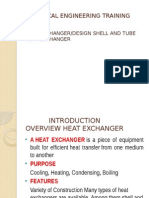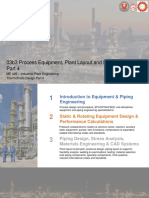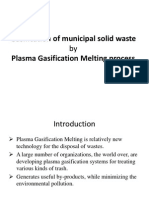Pumps
Pumps
Uploaded by
Jai AcharyaCopyright:
Available Formats
Pumps
Pumps
Uploaded by
Jai AcharyaCopyright
Available Formats
Share this document
Did you find this document useful?
Is this content inappropriate?
Copyright:
Available Formats
Pumps
Pumps
Uploaded by
Jai AcharyaCopyright:
Available Formats
Controlling Pump Performance
Changing the amount for friction loss or "Throttling the Pump"
will change the pump's performance
pumps
Water pumps are devices designed to convert
mechanical energy to hydraulic energy.
They are used to move water from lower
points to higher points with a required
discharge and pressure head.
This chapter will deal with the basic hydraulic
concepts of water pumps
Pump Classification
Turbo-hydraulic (kinetic) pumps
Centrifugal pumps (radial-flow pumps)
Propeller pumps (axial-flow pumps)
Jet pumps (mixed-flow pumps)
Positive-displacement pumps
Screw pumps
Reciprocating pumps
Impellers
Screw pumps.
In the screw pump a revolving shaft fitted with
blades rotates in an inclined trough and pushes the
water up the trough.
Reciprocating pumps.
In the reciprocating pump a piston sucks the
fluid into a cylinder then pushes it up
causing the water to rise.
This machine consists of an IMPELLER rotating
within a case (diffuser)
Liquid directed into the
center of the rotating
impeller is picked up by
the impellers vanes and
accelerated to a higher velocity by the rotation
of the impeller and discharged by centrifugal
force into the case (diffuser).
Centrifugal Pumps
Centrifugal Pump
Electric Motor
Centrifugal Pumps
Impeller
Vanes
Casing
Suction Eye Impeller
Discharge
Flow Expansion
Broad range of applicable flows and heads
Higher heads can be achieved by increasing the diameter or
the rotational speed of the impeller
Centrifugal Pump:
Centrifugal pumps (radial-flow pumps) are the most
used pumps for hydraulic purposes. For this reason,
their hydraulics will be studied in the following
sections.
Main Parts of Centrifugal Pumps
which is the rotating part of
the centrifugal pump.
It consists of a series of
backwards curved vanes
(blades).
The impeller is driven by a
shaft which is connected to the
shaft of an electric motor.
1. Impeller:
Main Parts of Centrifugal Pumps
Which is an air-tight
passage surrounding the
impeller
designed to direct the
liquid to the impeller
and lead it away
Volute casing. It is of
spiral type in which the
area of the flow
increases gradually.
2. Casing
3. Suction Pipe.
4. Delivery Pipe.
5. The Shaft: which is the bar by which the
power is transmitted from the motor drive to
the impeller.
6. The driving motor: which is responsible for
rotating the shaft. It can be mounted directly
on the pump, above it, or adjacent to it.
Note that a centrifugal pump can be
either submersible (wet) or dry.
The following terms can be defined
h
s
(static suction head): it is the difference in
elevation between the suction liquid level and the
centerline of the pump impeller.
h
d
(static discharge head): it is the difference in
elevation between the discharge liquid level and
the centerline of the pump impeller.
H
stat
(static head): it is the difference (or sum) in
elevation between the static discharge and the
static suction heads:
H h h
stat d s
=
Cavitation of Pumps and NPSH
In general, cavitation occurs when the liquid pressure
at a given location is reduced to the vapor pressure of
the liquid.
For a piping system that includes a pump, cavitation
occurs when the absolute pressure at the inlet falls
below the vapor pressure of the water.
This phenomenon may occur at the inlet to a pump and
on the impeller blades, particularly if the pump is
mounted above the level in the suction reservoir.
Under this condition, vapor bubbles form (water
starts to boil) at the impeller inlet and when these
bubbles are carried into a zone of higher pressure,
they collapse abruptly and hit the vanes of the
impeller (near the tips of the impeller vanes). causing:
Damage to the pump (pump impeller)
Violet vibrations (and noise).
Reduce pump capacity.
Reduce pump efficiency
To avoid cavitation, the pressure head at the inlet should not fall
below a certain minimum which is influenced by the further
reduction in pressure within the pump impeller.
To accomplish this, we use the difference between the total head
at the inlet , and the water vapor pressure head
g
V P
s s
2
2
+
vapor
P
How we avoid Cavitation ??
Where we take the datum through the centerline of the pump
impeller inlet (eye). This difference is called the Net Positive
Suction Head (NPSH), so that
NPSH
P V
g
P
s s
vapor
= +
2
2
There are two values of NPSH of interest. The first is the required NPSH,
denoted (NPSH)
R
, that must be maintained or exceeded so that cavitation
will not occur and usually determined experimentally and provided by the
manufacturer.
The second value for NPSH of concern is the available NPSH, denoted
(NPSH)
A
, which represents the head that actually occurs for the particular
piping system. This value can be determined experimentally, or calculated if
the system parameters are known.
How we avoid Cavitation ??
For proper pump operation (no cavitation) :
(NPSH)
A
> (NPSH)
R
Pump Characteristic Curves
Pump manufacturers provide information on the performance
of their pumps in the form of curves, commonly called pump
characteristic curves (or simply pump curves).
In pump curves the following information may be given:
the discharge on the x-axis,
the head on the left y-axis,
the pump power input on the right y-axis,
the pump efficiency as a percentage,
the speed of the pump (rpm = revolutions/min).
the NPSH of the pump.
N
P
S
H
-
m
Q (m /hr)
20
10
0 100 200
H
(
m
)
70
60
50
40
30
Pump Curve
NPSH
e
f
f
i
c
i
e
n
c
y
300
3
400
6
70%
60%
50%
40%
4
2
0
E
f
f
i
c
i
e
n
c
y
%
80%
This machine consists of an IMPELLER rotating
within a case (diffuser)
Liquid directed into the
center of the rotating
impeller is picked up by
the impellers vanes and
accelerated to a higher velocity by the rotation
of the impeller and discharged by centrifugal
force into the case (diffuser).
Centrifugal Pumps
Diameter of
the Impeller
Thickness
of the impeller
Centrifugal Impellers
Thicker the Impeller- More Water
Larger the DIAMETER - More Pressure
Increase the Speed - More Water and Pressure
Impeller
Vanes
Eye of the
Impeller
Water
Entrance
Two Impellers in Series
Direction of Flow
Twice the pressure
Same amount of water
Multiple Impellers in Series
Placing impellers in series increases the amount of head
produced
The head produced = # of impellers x head of one impeller
Direction of Flow Direction of Flow
Head is a term for expressing feet of water column
Head can also be converted to pressure
"Head"
100 feet
43.3 PSI
Reservoir of
Fluid
Pressure
Gauge
Conversion Factors Between Head and
Pressure
Head (feet of liquid) =Pressure in PSI x 2.31 / Sp. Gr.
Pressure in PSI = Head (in feet) x Sp. Gr. / 2.31
PSI is Pounds per Square Inch
Sp. Gr. is Specific Gravity which for water is equal to 1
For a fluid more dense than water, Sp. Gr. is greater than
1
For a fluid less dense than water, Sp. Gr. is less than 1
Pump Performance Curve
A mapping or graphing of the pump's ability to produce head and flow
Pump Performance Curve
Step #1, Horizontal Axis
The pump's flow rate is plotted on the horizontal axis
( X axis)
Usually expressed in Gallons per Minute
Pump Flow Rate
Pump Performance Curve
Step #2, Vertical Axis
Pump Flow Rate
The head the pump produces is plotted on the vertical axis (Y axis)
Usually express in Feet of Water
H
e
a
d
Pump Performance Curve
Step #3, Mapping the Flow and the Head
Pump Flow Rate
Most pump
performance
curves slope
from left to
right
Performance Curve
H
e
a
d
Pump Performance Curve
Important Points
Pump Flow Rate
H
e
a
d
Maximum Flow
Maximum Flow is the
largest flow the pump can
produce
No Head is produced
System Performance Curve
Step #3, Curve Mapping
The friction loss is mapped onto the graph
The amount of friction loss varies with flow through the
system
H
e
a
d
Pump Flow Rate
Friction Loss
H
e
a
d
Pump Flow Rate
PUMP SELECTION
Valve Open
Valve Partially Open
Valve Barely Open
Friction Loss Factors for Fittings
Fitting K
Standard 90
o
Elbow 30f
T
Standard 45
o
Elbow 16f
T
Standard Tee
20f
T
Run
60 f
T
Branch
Pipe Entrance 0.78
Pipe Exit 1.0
Friction Loss Factors for Valves
Valve K
Gate valve 8f
T
Globe Valve 340f
T
Swing Check Valve 100f
T
Lift Check Valve 600f
T
Ball Valve 3f
T
2
2
29.9
V
V
d
K
C
C Valve Coefficient
=
=
Fanning Diagram
f =16/Re
1
f
= 4.0 * log
D
c
+ 2.28
1
f
= 4.0*log
D
c
+ 2.28 4.0* log 4.67
D/c
Re f
+1
(
(
Centrifugal Pump
Electric
Motor
Centrifugal Pump
Converts
kinetic
energy to
pressure
energy
Impellers
Pump Head
The head of a pump can be expressed in metric units
as:
head = (p
2
- p
1
)/(g) + (v
2
2
- v
1
2
)/(2g) + (z
2
-z
1
)
where
h = total head developed (m)
p
2
= pressure at outlet (N/m
2
)
p
1
= pressure at inlet (N/m
2
)
= density of liquid (kg/m3)
g = acceleration of gravity (9.81) m/s
2
v
2
= velocity at the outlet (m/s)
Net Positive Suction Head-NPSH
Pumps can not pump vapors!
The satisfactory operation of a pump requires
that vaporization of the liquid being pumped
does not occur at any condition of operation.
Net Positive Suction Head Required, NPSH
R
As the liquid passes from the pump suction to the eye of the impeller, the velocity
increases and the pressure decreases. There are also pressure losses due to shock and
turbulence as the liquid strikes the impeller. The centrifugal force of the impeller vanes
further increases the velocity and decreases the pressure of the liquid. The NPSH required
is the positive head (absolute pressure) required at the pump suction to overcome these
pressure drops in the pump and maintain the liquid above its vapor pressure.
Positive Displacement Compressor
http://www.city-compressors.co.uk/
Centrifugal Compressors
Rotors
Stators
Jet
Engine
Design
Piston Compressor
Fans and Blowers
Types
Centrifugal (10
3
-10
5
acfm, P=1-40 in H
2
O)
Backward Curved
Straight radial
Vane Axial
Tube Axial
Cost of Fans and Blowers
Size factor = Volumetric Flow Rate
Motor
Producing Vacuum
Steam Ejector
Ejector
Produces Vacuum
Provides Low Pressures for Distillation
Columns
Fluid (P P
sat
)
Steam
for suction pressure below 100 mbar
absolute, more than one ejector will be
used, with condensors between the
ejector stages
Air
Water
Collects Particles in Gas Stream
Venturi Scrubber
CAVITATION
You might also like
- Equipment DetailsDocument33 pagesEquipment DetailsSaif Siddiqui100% (1)
- Distillation Column PipingDocument57 pagesDistillation Column PipingKaran Singh92% (13)
- PSV and PRV PDFDocument5 pagesPSV and PRV PDFMetoo Chy100% (2)
- PumpDocument48 pagesPumpArman Malik100% (2)
- Axial Flow PumpsDocument18 pagesAxial Flow PumpsVinay Chandwani100% (1)
- Cooling SystemsDocument30 pagesCooling SystemsTa Den April100% (1)
- PipeDocument47 pagesPipemohanNo ratings yet
- Piping ComponentsDocument39 pagesPiping Componentsbvenky991100% (1)
- Floating Head Heat Exchanger-MaintainanceDocument15 pagesFloating Head Heat Exchanger-MaintainanceEDY PRASETYONo ratings yet
- Piping Fittings: Elbows or EllsDocument17 pagesPiping Fittings: Elbows or Ellsleading_aliNo ratings yet
- Revised PPT SG HXDocument44 pagesRevised PPT SG HXskgbondNo ratings yet
- Presentation For Shell & Tub Heat ExchangerDocument33 pagesPresentation For Shell & Tub Heat ExchangerHoa Hoang PhuNo ratings yet
- Shell & Tube Heat Exchanger - PresentationDocument17 pagesShell & Tube Heat Exchanger - Presentationtantri.hellyantiNo ratings yet
- Piping Fundamentals:: M.N.RaghuDocument26 pagesPiping Fundamentals:: M.N.RaghuAlex Salvin100% (2)
- Piping QuizDocument20 pagesPiping QuizAlex CarreraNo ratings yet
- 03b3 - Equipment (Rotating Pumps)Document34 pages03b3 - Equipment (Rotating Pumps)John Lexmar LeynesNo ratings yet
- ASME B 31.3 - Process Piping CodeDocument2 pagesASME B 31.3 - Process Piping Codehemant sadafaleNo ratings yet
- 1Document156 pages1Abhijeet DarvekarNo ratings yet
- Fittings TrainingDocument61 pagesFittings Trainingsbmmla100% (1)
- Introduction To BoilersDocument36 pagesIntroduction To BoilersAdel SukerNo ratings yet
- Boiler MaintenanceDocument39 pagesBoiler MaintenanceAjay Chauhan100% (3)
- PumpsDocument46 pagesPumpsRiyadh SalehNo ratings yet
- Piping FundamentalsDocument54 pagesPiping FundamentalsAveen100% (2)
- Basics of Pipe For Oil & Gas EngineerDocument12 pagesBasics of Pipe For Oil & Gas EngineerMannuddin Khan100% (1)
- PIPING Engineering Interview Questions:-: Isolation, Regulation, Non-Return and Special PurposesDocument21 pagesPIPING Engineering Interview Questions:-: Isolation, Regulation, Non-Return and Special PurposesAdil KhawajaNo ratings yet
- Presentation On Heat ExchangersDocument54 pagesPresentation On Heat ExchangersNagendrababu Mahapatruni100% (2)
- 1 PipelineDocument69 pages1 PipelineEhab MohammedNo ratings yet
- Accommodating Expansion in Piping SystemsDocument52 pagesAccommodating Expansion in Piping SystemsBeomHee LeeNo ratings yet
- Safety Talk: Fired HeatersDocument58 pagesSafety Talk: Fired HeatersSaleem ChohanNo ratings yet
- Piping SystemsDocument30 pagesPiping SystemsSulabhNo ratings yet
- Air Cooler Piping Design Questionaries With AnswerDocument1 pageAir Cooler Piping Design Questionaries With AnswerVikash TiwariNo ratings yet
- Control Valves BasicsDocument203 pagesControl Valves Basicszeeshansuboor100% (1)
- Valves 1660544940Document141 pagesValves 1660544940richardNo ratings yet
- Failure Analysis of Heat Exchngers: An Approach and Case StudiesDocument51 pagesFailure Analysis of Heat Exchngers: An Approach and Case Studiessathish69100% (5)
- Pipeline Support1Document18 pagesPipeline Support1Mohamed RishaNo ratings yet
- Pumps: Pumps and Its TypesDocument34 pagesPumps: Pumps and Its TypesAmir Hamza100% (2)
- Air Fin CoolersDocument43 pagesAir Fin Coolersbharatbellad100% (2)
- Anti Cavitation Low Noise Cage Guided Control Valve Series 1200Document15 pagesAnti Cavitation Low Noise Cage Guided Control Valve Series 1200Ibra HimNo ratings yet
- Ahmed Deyab: Senior Process Engineer Process Simulation ConsultantDocument154 pagesAhmed Deyab: Senior Process Engineer Process Simulation ConsultantHamza AliNo ratings yet
- ValveDocument66 pagesValveUmar Draz100% (1)
- PSV Vs PRVDocument3 pagesPSV Vs PRVyogacruise100% (1)
- Codes and Standards: Piping EngineeringDocument23 pagesCodes and Standards: Piping EngineeringAnnieMalik100% (3)
- Piping Presentation L & TDocument61 pagesPiping Presentation L & TBukti SiahaanNo ratings yet
- Piping Presentation L & TDocument61 pagesPiping Presentation L & TJitendra SurveNo ratings yet
- Introduction To Column InternalsDocument7 pagesIntroduction To Column Internalsamit0% (1)
- Why A Shell and Tube Heat Exchanger?Document17 pagesWhy A Shell and Tube Heat Exchanger?Avishek KumarNo ratings yet
- Corrosion and Materials in Hydrocarbon Production: A Compendium of Operational and Engineering AspectsFrom EverandCorrosion and Materials in Hydrocarbon Production: A Compendium of Operational and Engineering AspectsNo ratings yet
- Basic Fundamentals of CENTRIFUGAL PUMP (By:-Shashi)Document42 pagesBasic Fundamentals of CENTRIFUGAL PUMP (By:-Shashi)RaduIon100% (3)
- Process Equipment Design and DrawingDocument35 pagesProcess Equipment Design and DrawingKutty Krishnan MankaraNo ratings yet
- PumpsDocument115 pagesPumpsMehmet Yılmaz100% (1)
- Centrifugal Pumps: P.K.Nagarajan SR - Lecturer School of Mechanical and Building Sciences VIT UniversityDocument30 pagesCentrifugal Pumps: P.K.Nagarajan SR - Lecturer School of Mechanical and Building Sciences VIT UniversityVikas Kumar100% (1)
- Basics of Centrifugal PumpsDocument60 pagesBasics of Centrifugal PumpsMajid Sattar100% (1)
- FM-II Week 5Document28 pagesFM-II Week 5khizeraftab1018No ratings yet
- PumpDocument116 pagesPumpV Dhinakaran75% (4)
- Boiler Feed PumpDocument46 pagesBoiler Feed Pumppratapsingh12100% (2)
- Concept of PumpsDocument66 pagesConcept of PumpswhisentantNo ratings yet
- FM-II Week 5 of Mechanical Engineering Week 05Document26 pagesFM-II Week 5 of Mechanical Engineering Week 05shanimalik8248No ratings yet
- Pumps and Industrial ApplicationDocument19 pagesPumps and Industrial Applicationdevasree reddyNo ratings yet
- Chapter 7Document28 pagesChapter 7lockas222No ratings yet
- Skill Practice 35-40 Gas LawsDocument4 pagesSkill Practice 35-40 Gas Lawsalison thaiNo ratings yet
- Steam Utilization in Textile InduastryDocument4 pagesSteam Utilization in Textile InduastryJonathan Fernandez0% (1)
- ProcessingDocument12 pagesProcessingJagan BoseNo ratings yet
- A Micro-Method of Determining The Boiling Point ofDocument8 pagesA Micro-Method of Determining The Boiling Point ofDekace pohuwato100% (1)
- Pressure PuzzleDocument2 pagesPressure PuzzleasdafafafNo ratings yet
- Intermolecular Forces Lesson PlanDocument4 pagesIntermolecular Forces Lesson Plancheryl.tayasNo ratings yet
- Condensed Matter Physics Materials Science Greek Solid Long-Range Order Crystal Glass Glass Transition Gels Thin FilmsDocument6 pagesCondensed Matter Physics Materials Science Greek Solid Long-Range Order Crystal Glass Glass Transition Gels Thin FilmsimnasNo ratings yet
- Gasification of Municipal Solid Waste in The Plasma Gasification Melting ProcessDocument23 pagesGasification of Municipal Solid Waste in The Plasma Gasification Melting ProcessArjuncv100% (3)
- Determination OF THE Band-Gap OF THE Semiconductor Using The Four Probe MethodDocument3 pagesDetermination OF THE Band-Gap OF THE Semiconductor Using The Four Probe MethodJø Ñń ÝNo ratings yet
- CVHF Presentation - Basic OperationDocument38 pagesCVHF Presentation - Basic OperationBer Salazar Jr100% (7)
- PSA Operation ManualDocument83 pagesPSA Operation ManualAbassyacoubouNo ratings yet
- Reference - Advanced Fluid Mechanics MIT 2.25Document1 pageReference - Advanced Fluid Mechanics MIT 2.25Hector ElizaldeNo ratings yet
- QP Cy Jam2022Document39 pagesQP Cy Jam2022rk.cognizanceNo ratings yet
- Absorber PDFDocument24 pagesAbsorber PDFpavijayaNo ratings yet
- Komponen Mol (Kmol/jam)Document81 pagesKomponen Mol (Kmol/jam)MayViviNo ratings yet
- Tutorium Refrigeration SolutionDocument20 pagesTutorium Refrigeration SolutionwanpudinNo ratings yet
- Vert Heater TreaterDocument2 pagesVert Heater TreaterJaveed KhanNo ratings yet
- Lecture 06Document17 pagesLecture 06ᄏᄏᄏNo ratings yet
- MSM-3 P Phases in Solids ( (Intro & Isomorphous System) PDFDocument15 pagesMSM-3 P Phases in Solids ( (Intro & Isomorphous System) PDFShashank SinghNo ratings yet
- Dos and Donts in FlowDocument19 pagesDos and Donts in FlowPatricia ReyesNo ratings yet
- A Periodic Table Logic ProblemDocument2 pagesA Periodic Table Logic Problemkjj7760No ratings yet
- Slug ForceDocument190 pagesSlug Forcevivek9199No ratings yet
- Air Liquide 2022 Article On Off Gas Use in SMRDocument5 pagesAir Liquide 2022 Article On Off Gas Use in SMRKokil JainNo ratings yet
- Chapter 1:: Petroleum Production SystemDocument20 pagesChapter 1:: Petroleum Production SystemJay JayNo ratings yet
- Specific Heat LF and LVDocument7 pagesSpecific Heat LF and LVYash PandeyNo ratings yet
- Factors That Affect Optical Properties of SemiconductorMaterialsDocument4 pagesFactors That Affect Optical Properties of SemiconductorMaterialsInternational Journal of Innovative Science and Research TechnologyNo ratings yet
- RPT6 CDocument19 pagesRPT6 CmimostarNo ratings yet
- Crystal DefectsDocument2 pagesCrystal DefectsVictory OkwuNo ratings yet
- Document 2Document3 pagesDocument 2Usman HasanNo ratings yet
- Problem Set MassDocument3 pagesProblem Set MassSummer Wynn Dacwag0% (1)

























































































